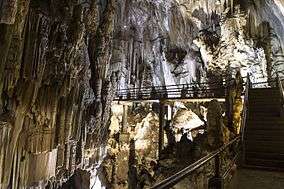Caverna do Diabo State Park
| Caverna do Diabo State Park | |
|---|---|
| Parque Estadual Caverna do Diabo | |
|
IUCN category II (national park) | |
|
Walkway in the Caverna da Tapagem | |
 | |
| Nearest city | Barra do Turvo, São Paulo |
| Coordinates | 24°39′36″S 48°27′17″W / 24.659955°S 48.454678°WCoordinates: 24°39′36″S 48°27′17″W / 24.659955°S 48.454678°W |
| Area | 40,174.82 hectares (99,274.1 acres) |
| Designation | State park |
| Created | 21 February 2008 |
| Administrator | Fundação Florestal SP |
The Caverna do Diabo State Park (Portuguese: Parque Estadual Caverna do Diabo) is a state park in the state of São Paulo, Brazil, established in 2008. It protects a mountainous area of Atlantic Forest, and is known for the dramatic Caverna da Tapagem or Caverna do Diabo, which draws thousands of visitors each year.
Location
The Caverna do Diabo State Park is divided between the muncipalities of Barra do Turvo, Cajati, Eldorado and Iporanga in São Paulo. It has an area of 40,174.82 hectares (99,274.1 acres). The Caverna do Diabo State Park was created by state law 12.810 of 21 February 2008.[1] It was one of several conservation units created by law 12.810 in which the Jacupiranga Mosaic was created from the former Jacupiranga State Park and its surrounding lands.[2] The park was created to preserve the Atlantic Forest biome.[3]
Environment
The Caverna do Diabo State Park is in a region that contains mixed rainforests and typical Atlantic Forest, with areas of araucaria. Heart of palm (Euterpe edulis) was once common, but steady clandestine extraction has greatly reduced its numbers.[4]
The vegetation is mainly dense submontane and montane rainforest. Near the cave there is secondary growth forest in an advanced state of regeneration, mainly the Myrtaceae, Fabaceae and Rubiaceae families. The canopy is about 25 metres (82 ft) high with emergents up to 32 metres (105 ft). On the slopes and higher up the forest is gradually replaced by herbaceous-shrubby fields. In a 2009 survey 154 species of trees were identified. There are many species of fauna with a high degree of endemism, including birds, small mammals, reptiles, amphibians and insects. Birds of prey, larger mammals and fish are present in smaller numbers.[5]
Attractions
About 27,000 people visit the park each year, mainly to see the cave, which is at the Caverna do Diabo Center in Eldorado at Km 111 on the SP-165 highway. The park base includes a visitor center, monitor center, restaurant, accommodation for researchers and parking. There are also some shops selling local handicrafts and souvenirs.[6] The visitor center provides environmental interpretation.[7] There are two trails in the park, the Araçá trail and the Mirador do Governador Trail.[3]
The Tapagem Cave (or Devil's Cave: Caverna do Diabo) was found in 1896 by Ricardo Krone. It follows an underground stretch of the Rio das Ostras in the Serra de André Lopes, and is over 5 kilometres (3.1 mi) long. It has been fitted with walkways and lighting to make it accessible to tourists.[4] There is an entrance fee, and also a fee for an environmental monitor, who must accompany visitors.[7]
Notes
Sources
- "Caverna do Diabo", PETAR Online (in Portuguese), retrieved 2016-11-21
- Leonel, Cristiane (2007), Plano de Manejo da caverna do Diabo (PDF) (in Portuguese), Fundação Florestal SP, retrieved 2016-11-21
- Parque Estadual Caverna do Diabo (in Portuguese), MMA: Ministério do Meio Ambiente, retrieved 2016-11-21
- Parque Estadual Caverna do Diabo (in Portuguese), SAP: Sistema Ambiental Paulista, retrieved 2016-11-21
- Sobre o Parque (in Portuguese), SAP: Sistema Ambiental Paulista, retrieved 2016-11-21
- Zanchetta, Inês; Bedeschi, Luciana (28 February 2008), Mosaico do Jacupiranga, no Vale do Ribeira, agora é lei (in Portuguese), ISA: Instituto Socioambiental, retrieved 2016-11-20
